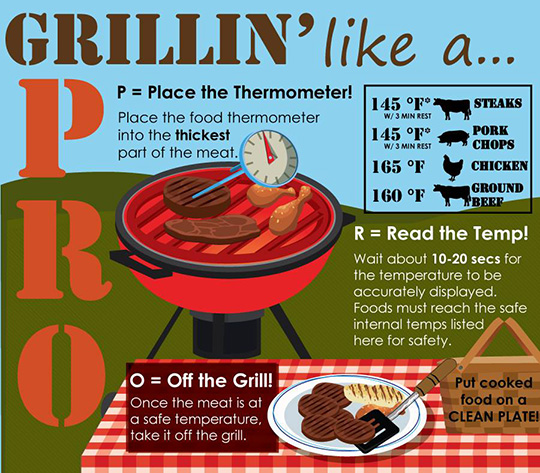Food Safety Tips For A Happier Fourth Of July
July 3, 2022
Due to a variety of factors, including warmer temperatures, foodborne illness increases in summer. Stay healthy and safe during warmer months by following these food safety recommendations from the USDA:
When bringing food to a picnic or cookout:
- Use an insulated cooler filled with ice or frozen gel packs. Frozen food can also be used as a cold source.
- Foods that need to be kept cold include raw meat, poultry, and seafood; deli and luncheon meats or sandwiches; summer salads (tuna, chicken, egg, pasta, or seafood); cut up fruit and vegetables; and perishable dairy products.
- A full cooler will maintain its cold temperature longer than a partially filled one. When using a cooler, keep it out of the direct sun by placing it in the shade or shelter.
- Avoid opening the cooler repeatedly so that your food stays colder longer.
When cooking on the grill:
- Use separate cutting boards and utensils for raw meat and ready-to-eat items like vegetables or bread.
- Keep perishable food cold until it is ready to cook.
- Use a food thermometer to make sure meat and poultry are cooked thoroughly to their safe minimum internal temperatures
- Beef, Pork, Lamb, & Veal (steaks, roasts, and chops): 145 °F with a 3 minute rest time
- Ground meats: 160 °F
- Whole poultry, poultry breasts, & ground poultry: 165 °F
- Always use a fresh, clean plate and tongs for serving cooked food. Never reuse items that touched raw meat or poultry to serve the food once it is cooked.
When serving food outdoors:
- Perishable food should not sit out for more than two hours. In hot weather (above 90 °F), food should NEVER sit out for more than one hour.
- Serve cold food in small portions, and keep the rest in the cooler. After cooking meat and poultry on the grill, keep it hot until served – at 140 °F or warmer.
- Keep hot food hot by setting it to the side of the grill rack, not directly over the coals where they could overcook.




Comments